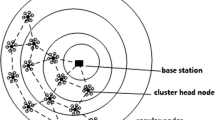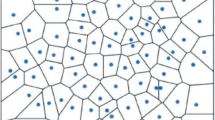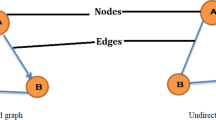Abstract
Wireless sensor network (WSNs) technology and Internet technology penetrate and extend each other. It is a good way for physical changes of objects, state recognition and data collection, and becomes an important source of network data in big data. Compared with traditional wireless networks, WSNs have the characteristics of integrating sensing, processing, and transmission, limited hardware resources, limited power supply capacity, no center, self-organization, multi-hop routing, dynamic topology, large number of nodes, and dense distribution. In order to improve the energy utilization rate of a single node to a greater extent, reduce the energy consumption of the entire WSNs, and extend the life cycle of WSNs, high-efficiency networking is essential in the application of WSNs. Networking is one of the foundations to the large-scale WSNs. The network model and node location deployment are important technologies for WSNs networking. Based on the network characteristics of large-scale WSNs and the transmission capacity of big data, a new type of network model suitable is presented which combined the advantages of Star model and Mesh model. More importantly, the deployment environment of sensor nodes is a spatial network. The data collected and transmitted by large-scale WSNs is very large. The deployment of sensor nodes in space can ensure that the big data collected and transmitted are true and effective. This research proposes the space density first (SDF) algorithm, which improves the neighbor density first algorithm with the space node deployment and the density-optimized SDF algorithm. The SDF algorithm saves network energy and extends the life of the network. Experimental results show that large-scale WSNs built with a new networking model and SDF algorithm can collect and transmit big data stably and reliably, which saves network energy and improves the accuracy of big data.

















Similar content being viewed by others
References
Mohsen M, Fariza N, Gani A, Ahmad K, Targio HIA, Aisha S, Ibrar Y (2017) Big IoT data analytics: architecture, opportunities, and open research challenges. IEEE Access 5:5247–5261
Zhang Q, Yang LT, Chen Z, Li P (2018) A survey on deep learning for big data. Inf Fus 42:146–157
Sabrina B, Eddine BD, Azeddine B, Homero T-C (2018) Big data challenges and data aggregation strategies in wireless sensor networks. IEEE Access 6:20558–20571
Femminella M, Pergolesi M, Reali G (2018) IoT, big data, and cloud computing value chain: pricing issues and solutions. Ann Telecommun 73(7):511–520
Wolfert S, Ge L, Verdouw C, Bogaardt M-J (2017) Big Data in Smart Farming – A review. Agric Syst 153:69–80
Zhou L, Pan S, Wang J, Vasilakos AV (2017) Machine learning on Big Data: opportunities and challenges. Neurocomputing 237:350–361
Shen L, Ma J, Liu X, Wei F, Miao M (2017) A secure and efficient ID-based aggregate signature scheme for wireless sensor networks. IEEE Internet Things J 4(2):546–554
Cai H, Boyi Xu, Jiang L, Vasilakos AV (2017) IoT-based big data storage systems in cloud computing: perspectives and challenges 4(1):75–87
Yetgin H, Cheung KTK, El-Hajjar M, Hanzo L (2017) A survey of network lifetime maximization techniques in wireless sensor networks. IEEE Commun Surv Tutor 19(2):828–854
Hana R, Karim T, Ryma A, Damien S, Sihem G (2018) A multi-hop graph-based approach for an energy-efficient routing protocol in wireless sensor networks. HCIS 8:1–21
Xia H, Zhang R-H, Jia Yu, Pan Z-K (2016) Energy-efficient routing algorithm based on unequal clustering and connected graph in wireless sensor networks 23:141–150
Sun G, Liu Y, Liang S, Chen Z, Wang A, Qianao Ju, Zhang Y (2017) A sidelobe and energy optimization array node selection algorithm for collaborative beamforming in wireless sensor networks. IEEE Access 6:2515–2530
Hamouda YEM, Msallam MM (2019) Smart heterogeneous precision agriculture using wireless sensor network based on extended Kalman filter. Neural Comput Appl 31(9):5653–5669
Ang K-M, Seng JKP, Zungeru AM (2018) Optimizing energy consumption for big data collection in large-scale wireless sensor networks with mobile collectors. IEEE Syst J 12(1):616–626
Ndiaye M, Hancke GP, Abu-Mahfouz AM (2017) Software defined networking for improved wireless sensor network management: a survey. Sensors 17(5):1–32
Muhammad A, Shafiullah K, Rashid A, Muhammad S, Dhananjay S (2017) Quality of service of routing protocols in wireless sensor networks: a review. IEEE Access 5:1846–1871
Kuo Y-W, Li C-L, Jhang J-H, Lin S (2018) Design of a wireless sensor network based IoT platform for wide area and heterogeneous applications. IEEE Sens J 18(12):5187–5197
Jin Wang Yu, Gao WL, Sangaiah AK, Kim H-J (2019) An improved routing schema with special clustering using PSO algorithm for heterogeneous wireless sensor network. Sensors 19(3):1–17
Maurya S, Jain VK, Chowdhury DR (2019) Delay aware energy efficient reliable routing for data transmission in heterogeneous mobile sink wireless sensor network. J Netw Comput Appl 144:118–137
Verma S, Sood N, Sharma AK (2019) A novelistic approach for energy efficient routing using single and multiple data sinks in heterogeneous wireless sensor network. Netw Appl 12:1110–1136
Verma S, Sood N, Sharma AK (2019) Genetic Algorithm-based Optimized Cluster Head selection for single and multiple data sinks in Heterogeneous Wireless Sensor Network. Appl Soft Comput J 85:1–21
Kaushal K, Kaur T, Kaur J (2014) ZigBee based wireless sensor networks. Int J Comput Sci Inf Technol 5(6):7752–7755
Jiasong Mu (2017) An improved AODV routing for the zigbee heterogeneous networks in 5G environment. Ad Hoc Netw 58:13–24
Huang Y, Pang A, Hsiu P, Zhuang W, Liu P (2012) Distributed throughput optimization for ZigBee cluster-tree networks. IEEE Trans Parallel Distrib Syst 23(3):513–520
Yang F, Chen Y (2015) Heterogeneous networking technology research on wireless sensor networks in Internet of Things. J Hunan Univ Sci Technol 30(1):86–92
Castagnetti A, Pegatoquet A, Le TN, Auguin M (2014) A joint duty-cycle and transmission power management for energy harvesting WSN. IEEE Trans Ind Inf 10(2):928–936
Acknowledgements
This work was supported in part by the Innovative Province Construction Special Project of Hunan, China (Grant No. 2020NK2033), by the Scientific Research Fund of Hunan Provincial Education Department, China (Grant No. 20A249 and Grant No. 20A259), and in part by the Scientific Research and Technology Development Project of Hezhou, China (Grant No. HeGongJian1908016). (Corresponding authors: Xinghui Zhu; Kui Fang.)
Author information
Authors and Affiliations
Corresponding authors
Ethics declarations
Conflict of interest
All authors of this manuscript have no conflict of interest, financial or otherwise. And there are no other relationships or activities that could appear to have influenced the submitted work.
Additional information
Publisher's Note
Springer Nature remains neutral with regard to jurisdictional claims in published maps and institutional affiliations.
Rights and permissions
About this article
Cite this article
Chen, Y., Zhu, X., Fang, K. et al. An improved method for sink node deployment in wireless sensor network to big data. Neural Comput & Applic 34, 9499–9510 (2022). https://doi.org/10.1007/s00521-021-06443-3
Received:
Accepted:
Published:
Issue Date:
DOI: https://doi.org/10.1007/s00521-021-06443-3




